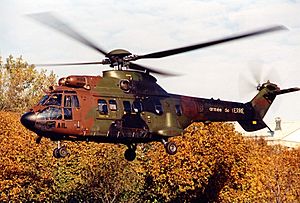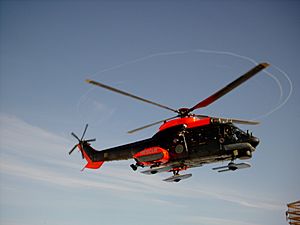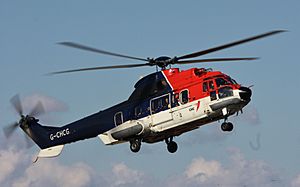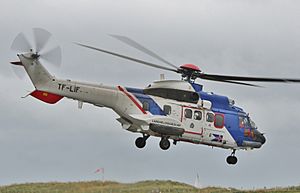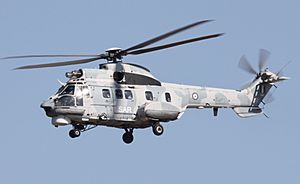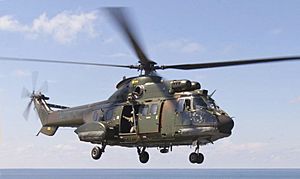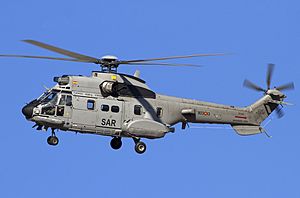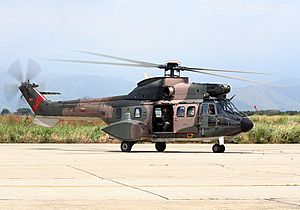Eurocopter AS332 Super Puma facts for kids
Quick facts for kids AS332 Super PumaH215 |
|
|---|---|
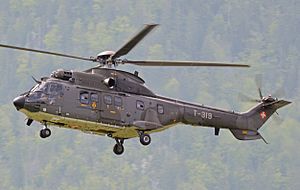 |
|
| AS332M1 Super Puma of the Swiss Air Force | |
| Role | Medium utility helicopter |
| National origin | France |
| Manufacturer | Aérospatiale Eurocopter Airbus Helicopters |
| First flight | 13 September 1978 |
| Status | In service |
| Primary users | French Air and Space Force CHC Helicopter Babcock Mission Critical Services Offshore Spanish Air and Space Force |
| Produced | 1978–present |
| Number built | 1,000 (Sep 2019) |
| Developed from | Aérospatiale SA 330 Puma |
| Variants | Eurocopter AS532 Cougar |
| Developed into | Eurocopter EC225 Super Puma |
The Airbus Helicopters H215 (also known as the Eurocopter AS332 Super Puma) is a powerful helicopter with four main rotor blades and two engines. It's a medium-sized helicopter used for many different jobs. It was first made by a French company called Aérospatiale. Later, other companies like Eurocopter and Airbus Helicopters took over its production. The Super Puma is an improved version of an older helicopter called the Aérospatiale SA 330 Puma. It has stronger engines and more space inside.
This helicopter was developed in the 1970s. Its body was made stronger to handle damage better, and it used more modern materials. It also got new, more powerful engines and a smoother nose design. There were two main sizes: a shorter one and a longer one. The first Super Puma flew on September 13, 1978. By 1980, the Super Puma became the main utility helicopter for Aérospatiale.
The Super Puma quickly became very popular with both military and civilian customers. The French Army used it for quick response missions. Countries like Indonesia even got a special license to build it themselves. In civilian life, it's often used to carry people and supplies to oil rigs far out at sea. It also helps with aerial firefighting. Since 1990, military versions of the Super Puma have been called the Eurocopter AS532 Cougar. A newer, even bigger version for civilian use, the Eurocopter EC225 Super Puma, came out in 2004.
Contents
How the Super Puma Was Developed
Its Beginnings
In 1974, Aérospatiale started working on a new helicopter. It was based on their successful SA 330 Puma. They announced this new project at the 1975 Paris Air Show. The new helicopter looked similar to the SA 330, but it had two new, more powerful engines. Its four main rotor blades were also made with new, strong materials.
The designers focused on making the new helicopter very tough. They gave it a stronger body and a special undercarriage that could handle hard landings. Even the rotor blades were designed to withstand some damage.
You can tell the Super Puma apart from the older SA 330 by a small fin under its tail and a smoother nose. From the start, the plan was to make two sizes. A shorter version would be similar in size to the SA 330 but perform better in hot, high places. A longer version could carry more people or cargo.
The first test helicopter, called the SA 331, flew on September 5, 1977. It was a modified SA 330 with the new engines. The very first true Super Puma flew on September 13, 1978. Five more test helicopters quickly followed. Tests showed that the Super Puma was faster and could fly further than the SA 330. Its engines also used less fuel. The Super Puma was also more stable in the air. Both military and civilian versions were developed at the same time. The first civilian Super Puma was delivered in 1981.
Making More and Making it Better
By 1980, the AS 332 Super Puma had become Aérospatiale's main helicopter. It was very popular. Between 1981 and 1987, about three Super Pumas were built every month for customers around the world. Because it was so successful, more advanced models were developed. These new models had longer rotor blades, even more powerful engines, and updated electronics. Some countries, like Indonesia, even built the Super Puma under a special agreement.
Many different types of Super Pumas were made. These included special versions for search-and-rescue (SAR) and for finding submarines. Since 1990, military Super Pumas have been known as the AS532 Cougar. By 2005, Super Pumas were used by customers in 38 countries for many different jobs. Over 565 Super Pumas (including Cougars) had been delivered or ordered by then.
In 2012, Eurocopter announced a simpler, lower-cost Super Puma. This new version, called the AS 332 C1e, was designed to compete with other helicopters. In 2015, Airbus Helicopters announced that the AS 332 Super Puma, now called the H215, would be built in a new factory in Brasov, Romania. This move aims to make building the helicopter faster and cheaper.
How the Super Puma is Designed
The Eurocopter AS332 Super Puma is a medium-sized helicopter. It has two powerful Turbomeca Makila 1A1 engines. These engines power the helicopter's four main rotor blades and its five tail rotor blades. They also power two separate hydraulic systems and two electrical systems. The helicopter carries fuel in six internal tanks, and it can add more tanks for longer flights. For safety, the fuel tanks are designed to be crash-resistant, and the engine area has fire detection and suppression systems.
The tail of the helicopter is strong and has protection for the tail rotor. There's also a luggage area in the front part of the tail. The landing gear can be pulled up into the helicopter during flight and is designed to absorb a lot of energy during landing.
The main cabin of the Super Puma has two sliding doors. The floor can be arranged in different ways to carry passengers or cargo. It can even be set up for medical missions. According to Airbus Helicopters, the shorter Super Puma can carry up to 15 passengers plus two pilots. The longer version can carry up to 20 passengers. The cabin is soundproofed and has adjustable heating and ventilation. There are 12 windows along the sides of the cabin, which can be opened as emergency exits. Special floating gear can be added to the bottom of the helicopter to help it float on water.
The Super Puma has an advanced flight control system and a digital autopilot. The cockpit has controls for both pilots. The main instruments are shown on four large screens. There are also backup systems for safety. Many companies offer upgrades for the Super Puma, including navigation systems, GPS, digital maps, flight recorders, and collision warning systems.
A special version of the Super Puma is made for naval missions, like finding submarines or attacking ships. This version has extra protection against rust, a tail that can fold, and special radar. For attacking ships, it can carry Exocet missiles.
Where the Super Puma is Used
In August 1983, the French government created a quick-response military group. About 30 Super Pumas were used by this group to help France's allies and support missions in Africa and the Middle East. For example, in 1994, Super Pumas helped transport French troops and equipment during a mission in Rwanda.
Indonesia has been a very important customer for the Super Puma. An Indonesian company called PT DI builds the helicopter under a special agreement. The Indonesian Air Force ordered 16 Super Pumas to replace older helicopters. The Indonesian government also ordered 16 Super Pumas for VIP transport.
Switzerland bought 15 Super Pumas for its Swiss Air Force. They use them for scouting missions and search-and-rescue. Swiss Super Pumas have also helped with humanitarian aid, like fighting wildfires in Greece in 2021.
Sweden bought 12 Super Pumas in 1988. They were mostly used in Sweden, but some helped with medical evacuations in Afghanistan. In 2015, the Swedish Air Force stopped using its Super Pumas, replacing them with newer helicopters. Six of these retired Super Pumas were sold to other operators.
Nigeria also uses Super Pumas. In 2009, they bought five more used Super Pumas for peacekeeping and surveillance. Some Super Pumas used by the Nigerian Air Force have even been armed for anti-insurgency operations.
The Hellenic Air Force (Greece) bought Super Pumas starting in 1998 to replace older search-and-rescue helicopters. They needed helicopters that could fly in all weather, day or night, and cover long distances. These Super Pumas have special features like an autopilot, navigation computers, thermal cameras, and search radars. They can also carry six stretchers for medical missions.
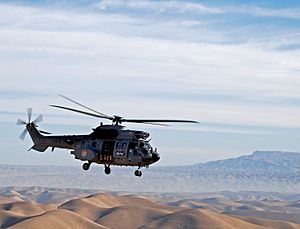
The Spanish Air Force has used Super Pumas for many jobs. They were used in Afghanistan from 2005 to 2011 for combat search-and-rescue and medical evacuations. They also help with firefighting in Spain. Spain is now replacing its Super Pumas with newer helicopters.
In Brazil, two modified Super Pumas were used to transport the President of Brazil. These helicopters could carry up to 15 passengers. Many French presidents have also used military Super Pumas for official travel.
The Super Puma is very popular for offshore operations, especially in the North Sea oil industry. It carries workers and equipment to and from oil platforms. Large civilian helicopter companies like Bristow Helicopters and CHC Helicopters operate many Super Pumas. Iran and Brazil also use Super Pumas for their oil exploration missions. The largest civilian helicopter operator in China also has a big fleet of Super Pumas. Germany's Federal Police service operates at least 19 Super Pumas.
The Finnish Border Guard uses Super Pumas for sea patrols and search-and-rescue. They are equipped for challenging weather, with thermal cameras, autopilot, and de-icing systems. Some older Finnish Super Pumas have been updated to the newer H215 standard.
By 2014, Airbus Helicopters had delivered 890 Super Pumas and Cougars to customers in 56 countries. By 2015, military customers had ordered 187 Super Pumas.
Different Types of Super Pumas

- SA 331 – The very first test helicopter, based on an older model.
- AS 332A – An early version for civilian use.
- AS 332B – A military version.
- AS 332B1 – The first military version.
- AS 332C – The main civilian production version.
- AS 332C1 – A search-and-rescue version with radar and space for six stretchers.
- AS 332F – A military version for finding submarines and attacking ships.
- AS 332F1 – A naval version.
- AS 332L – A civilian version with more powerful engines, a longer body, more cabin space, and a larger fuel tank.
- AS 332L1 – A stretched civilian version with a long body and an airline-style interior.
- AS 332L2 Super Puma Mk 2 – A civilian transport version with updated rotor head and electronic flight displays.
- AS 332M – A military version of the AS 332L.
- AS 332M1 – A stretched military version.
- NAS 332 – Versions built under license by IPTN (now Indonesian Aerospace PT DI) in Indonesia.
- VH-34 – The name for two VIP-configured Super Pumas used by the Brazilian Air Force.
Who Uses the Super Puma
Civilian Users
- State Emergency Service of Ukraine
- Petrobras
- CITIC Offshore Helicopter
- CHC Helicopter
- German Federal Police
- Hellenic Fire Service - Operates two AS332L.1s.
- Government Flying Service
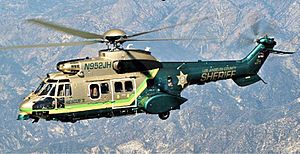
- Icelandic Coast Guard
- Coast Guard
- Tokyo Fire Department
- Lufttransport
- Serbian Police (3 on order)
- Bond Offshore Helicopters
- Bristow Helicopters
- CHC Scotia
- Los Angeles County Sheriff's Department
- Southern Vietnam Helicopter Company
Military Users
- Albanian air force
- National Guard of Ukraine
- Argentine Army Aviation
- Bolivian Air Force
- Brazilian Air Force
- Brazilian Naval Aviation
- Ecuadorian Army
- Finnish Border Guard
- Gabonese Air Force
- Ministry of Defense
- Hellenic Air Force
- Indonesian Air Force
- Indonesian Navy
- Royal Jordanian Air Force
- Kuwait Air Force
- Royal Moroccan Gendarmerie
- Mali Air Force
- Nigerian Air Force
- Royal Air Force of Oman
- Royal Saudi Navy
- Republic of Singapore Air Force
- Republic of Korea Air Force
- Spanish Air and Space Force
- Swiss Air Force
- Venezuelan Air Force
- Uzbekistan Air Force
Former Users
- Cameroon Air Force
- People's Liberation Army Ground Force
- Congolese Democratic Air Force
- Japan Ground Self-Defense Force
- Swedish Air Force
- Royal Thai Air Force
- Togolese Air Force
Safety and Incidents
Like all complex machines, helicopters can sometimes be involved in incidents. When this happens, experts investigate to understand what happened and how to make flying even safer. Over the years, there have been a few incidents involving Super Pumas. These investigations have helped improve helicopter safety for everyone.
For example:
- In 1988, a Super Puma had to land in the North Sea due to a part coming off a rotor blade. Everyone on board survived.
- In 1997, a Super Puma crashed after a main gearbox issue, leading to important safety recommendations.
- In 2009, a Super Puma crashed in the North Sea. Investigations into such events help improve helicopter design and maintenance.
- In 2013, a Super Puma landed hard in the North Sea. Four passengers died, but most survived thanks to the helicopter's flotation system.
- In 2023, a Super Puma crashed in Ukraine during low visibility conditions.
These events, while tragic, lead to continuous improvements in helicopter safety and design.
Super Puma Facts (AS332 L1)
Data from Jane's All The World's Aircraft 1993–94
General characteristics
- Crew: 2 pilots
- Capacity: Up to 24 passengers plus an attendant, or about 4,490 kg (9,899 lb) of cargo.
- Length: 16.79 m (55 ft 1 in) (fuselage)
-
-
-
- 18.7 m (61 ft 4 in) with rotors turning
-
-
- Height: 4.97 m (16 ft 4 in)
- Empty weight: 4,660 kg (10,274 lb)
- Max takeoff weight: 9,150 kg (20,172 lb)
- Powerplant: 2 × Turbomeca Makila 1A1 turboshaft, 1,376 kW (1,845 hp) each
- Main rotor diameter: 16.2 m (53 ft 2 in)
- Main rotor area: 206.12 m2 (2,218.7 sq ft)
- Blade shape: root: NACA 13112; tip: NACA 13106
Performance
- Cruise speed: 277 km/h (172 mph; 150 kn) (maximum),
-
-
-
- 247 km/h (153 mph; 133 kn) (economical)
-
-
- Never exceed speed: 327 km/h (203 mph; 177 kn)
- Range: 851 km (529 mi; 460 nmi)
- Service ceiling: 5,180 m (16,990 ft)
- Rate of climb: 7.4 m/s (1,460 ft/min)
|
- Aircraft related to this one
- Aérospatiale Puma
- IAR 330
- Eurocopter AS 532
- Eurocopter EC225
- KAI Surion
- Similar aircraft
- Lists related to this aircraft
- List of rotorcraft
See also
 In Spanish: Airbus Helicopters H215 para niños
In Spanish: Airbus Helicopters H215 para niños


